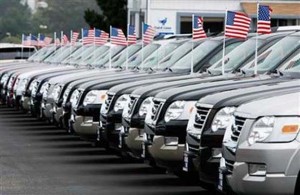New car sales are stronger than they have been since the start of the Great Recession, and likely to keep climbing, according to industry analysts. Demand is expected to be especially strong in the coming weeks, with August traditionally one of the hottest months of the year at dealer showrooms.
The good news for consumers is that despite surging demand, interest rates remain at near-recession lows. That’s led many buyers to move up-market by stretching out loans to five, six and even seven years. But if you’re in the market for a new car, truck or crossover, should you be buying or leasing? Are there, in fact, other even more affordable options?
A new study underscores the financial advantages of leasing over buying, but it also points to a potential alternative, a small but growing number of motorists opting to take over existing leases, something equivalent to buying a “nearly new” vehicle.
The study, by website Swapalease.com, takes an apples-to-apples approach, starting out with a generic, $30,000 vehicle and factoring in such things as maintenance, sales taxes, document fees and residuals – the latter being the amount a vehicle depreciates over a set period of time. The three alternatives were based on a motorist either purchasing a new vehicle and keeping it for six years while paying off the loan, leasing two vehicles during the same, 72-month period, or taking over four existing leases, each for 18 months.
For someone buying their vehicle and hanging onto it for six years, the total cash outlay, according to the analysis, came to $42,445.09, according to Scott Hall, the executive vice president of operations at Swapalease. That figure included a $2,500 extended service contract to cover repairs after the vehicle’s warranty ran out, a common and reasonable expense that lowered the forecast maintenance fees.
(What sort of car can you get for $1 million? Click Here to find out.)
The website calculated a $39,670.70 cash outlay over 72 months for someone who instead chose to lease two vehicles during the same period. The biggest difference? Lower depreciation, since leases cover only the actual decline in value during the period you are, in effect, renting the vehicle. That works out to a savings of $2,774.39, and the analysis is in line with other studies comparing buying versus leasing.
That said, someone considering the two options have several things to keep in mind. Buying a car is often more appealing to those motorists who like to keep their vehicle for a longer period of time, rather than having to shop for another vehicle every two to three years, acknowledged Hall, who said “There is that mindset.”
(Car sales surge in July. Click Herefor the numbers and more.)
And when you own, you don’t have to worry about the miles you put on the vehicle. Leases normally set a cap on mileage, whether 10,000, 12,000 or 15,000 miles annually. Go above that and you could pay a significant penalty. The Swapalease analysis was based on the mid-range option, 12,000 miles a year.
“If someone is going to drive a considerable more number of miles,” the price for a lease would go up, and “would definitely close the gap,” cautioned Hall. On the flip side, putting more miles on a vehicle, especially in later years, would also increase maintenance costs.
Another factor to consider: after years of holding below the rate of inflation, new vehicle prices have begun to rise more rapidly, so that $30,000 vehicle could be a fair bit more expensive when you go back to renew a lease in three years. On the other hand, costs are rising, in part, because manufacturers are adding lots of new technology, so you could find a lot of new safety, comfort and convenience features.
That would be a potential plus for someone who goes with the option behind door number three, assuming someone else’s lease. This is a fairly recent phenomenon, but gaining traction as more motorists choose to get out of a lease early. There are some additional charges, notably a lease transfer fee that, Swapalease estimated, runs around $600.
But the savings here can be significant. The study focused on someone who would assume four leases during the same 72-month period, coming up with a total out-of-pocket expense of $37,040.70. That’s $5,404.39 less than buying, and $2,630 less than a conventional lease.
(Fuel economy continues to improve despite surge in truck sales. Click Here for the latest.)
Someone assuming a lease needs to be aware that they would be getting into a used, not new, vehicle, albeit one that might be only 12 to 18 months old. But the financial trade-off might more than make up for the lack of that new car smell.
Each of the three alternatives has its advantages – and its drawbacks. The good news is that car shoppers now have more options than ever when choosing how to finance their vehicle.


Uh, Paul. Do you think it might be appropriate to factor in the residual value of the car that you own at the end of the 6 year purchase with the “nothing” that you own following leasing?
Fair point, Laurence. To be clear, I could’ve expanded this story significantly with a lot more details and factors to consider but had to find a reasonable point to cut off, leaving readers to develop additional factors of their own.
Paul E>